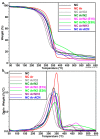Treatment of Nanocellulose by Submerged Liquid Plasma for Surface Functionalization
- PMID: 29949943
- PMCID: PMC6070974
- DOI: 10.3390/nano8070467
Treatment of Nanocellulose by Submerged Liquid Plasma for Surface Functionalization
Abstract
Tailoring the surface properties of nanocellulose to improve the compatibility of components in polymer nanocomposites is of great interest. In this work, dispersions of nanocellulose in water and acetonitrile were functionalized by submerged plasmas, with the aim of increasing the quality of this reinforcing agent in biopolymer composite materials. Both the morphology and surface chemistry of nanocellulose were influenced by the application of a plasma torch and filamentary jet plasma in a liquid suspension of nanocellulose. Depending on the type of plasma source and gas mixture the surface chemistry was modified by the incorporation of oxygen and nitrogen containing functional groups. The treatment conditions which lead to nanocellulose based polymer nanocomposites with superior mechanical properties were identified. This work provides a new eco-friendly method for the surface functionalization of nanocellulose directly in water suspension, thus overcoming the disadvantages of chemical treatments.
Keywords: dielectric barrier discharge; nanocellulose; plasma treatment; polymer nanocomposite; submerged liquid plasma.
Conflict of interest statement
The authors declare no conflict of interest.
Figures










References
-
- Grishkewich N., Mohammed N., Tang J., Tam K.C. Recent advances in the application of cellulose nanocrystals. Curr. Opin. Colloid Interface Sci. 2017;29:32–45. doi: 10.1016/j.cocis.2017.01.005. - DOI
-
- Sindhu K.A., Prasanth R., Thakur V.K. Medical applications of cellulose and its derivatives: Present and future. In: Thakur V.K., editor. Nanocellulose Polymer Nanocomposites. Fundamentals and Applications. Wiley-Scrivener; Hoboken, NJ, USA: 2015. pp. 461–462.
-
- Nechyporchuk O., Belgacem M.N., Bras J. Production of cellulose nanofibrils: A review of recent advances. Ind. Crops Prod. 2016;93:2–25. doi: 10.1016/j.indcrop.2016.02.016. - DOI
-
- García A., Gandini A., Labidi J., Belgacem N., Bras J. Industrial and crop wastes: A new source for nanocellulose biorefinery. Ind. Crops Prod. 2016;93:26–38. doi: 10.1016/j.indcrop.2016.06.004. - DOI
LinkOut - more resources
Full Text Sources
Other Literature Sources

